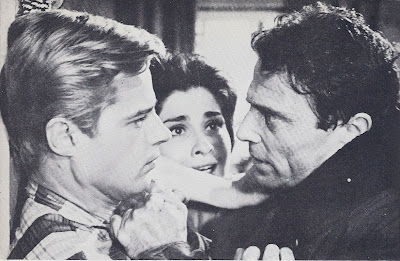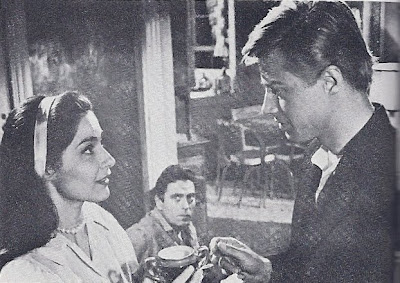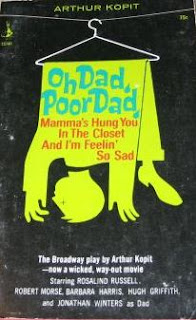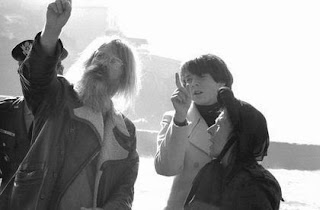
Ben Gazzara and John Cassavetes get intimate in Cassavetes' arresting "Husbands"(1970)
Turner Classic Movies covers a lot of ground this month, with esoteric tributes to Method Acting, the New York Film Critics Circle and Russia.

Jimmy Stewart in two different moods in two different genres
1 January: The jaw-dropping versatility of James Stewart is honored on the first day of the new year, starting at 6:45 a.m. with Richard Quine’s “Bell, Book and Candle” (1958), followed by Otto Preminger’s “Anatomy of a Murder” (1959), Sam Wood’s “The Straton Story” (1949), Anthony Mann’s “The Man from Laramie” (1955). John Ford’s “The Man Who Shot Liberty Valence” (1962) and the Henry Hathaway segment (“The Rivers”) of “How the West Was Won” (1962). (
Repeats: "Bell, Book and Candle" on
24 January at 12:30 p.m. and "Anatomy of a Murder" on
14 January at 3:30 p.m.)
 2 January:
2 January: For a bit of kink, there's David Lynch’s “Blue Velvet” (1986) at 2:15 a.m. and Nicholas Roeg’s “Bad Timing” (1980) immediately following at 4:15 a.m. And the male mid-life crisis is examined in both Stanley Kubrick’s “Lolita” (1962) at 8 p.m. and John Cassavetes' “Husbands” (1970) at 10:45 p.m. - and with such accuracy that you will wince and smile at the same time.
Falk, Gazarra and Cassavetes in "Husbands" (1970)
 3 January:
3 January: Robert Wise’s “Two for the Seesaw” (1962) at 3:15 a.m. is based on the William Gibson two-hander that starred Henry Fonda and Anne Bancroft. For his film, Wise went with Robert Mitchum and Shirley MacLaine, who would team with Bancroft years later in Herbert Ross' "The Turning Point."
4 January: Alfred E. Green’s “Top Banana” (1954) at 2:30 p.m. is a truncated, filmed-on-stage version of the Phil Silvers-Rosemarie musical comedy. The film, originally 100 minutes, is now 84 minutes and is missing two musical numbers and, not surprisingly, its 3-D sequences. This is the version that was released on video by MGM Home Entertainment back in the day.

Cyd Charisse could do more than dance (here with Fred Astaire), as Turner programmers prove
5 January: Samuel Goldwyn, Jr.’s “The Young Lovers” (1964) at 1:45 p.m. is the usual soap opera warning that sex leads to pregnancy. The couple in trouble is played by Peter Fonda and Sharon Hugueny, with Nick Adams, Deborah Walley and Jennifer Billingsly in support. Earlier in the day, Cyd Charisse is showcased in one of her rare non-dancing roles in Vincente Minnelli’s “Two Weeks in Another Town” (1962) at 9:45 a.m.
On
12 January, Charisse has a solid dramatic role in Nicholas Ray’s terrific mob flick, “The Party Girl” (1958), co-starring Robert Taylor and the great Lee J. Cobb. It airs at 6 a.m.


The singular Sandy Dennis gets a two-film tribute
5 January: The too-often neglected Sandy Dennis had one of her best roles in Robert Mulligan’s immensely popular “Up the Down Staircase” (1967), one of handful of gems that Mulligan made in tandem with producer Alan J. Pakula. Based on Bel Kaufman's enduring novel, set in an inner-city New York high school, the film underlines the soul-killing bureaucracy of the school system that, unbelievably, has gotten worse and more intense in the four decades since the film was made.
"Up the Down Staircase" has a huge supporting cast, led by the Irish stage actor Patrick Bedford (in one of only two film performances that he gave) and a gallery of noted actors from the Broadway stage - the wonderful Ruth White, Florence Stanley, Roy Poole, Frances Sternhagen, Eileen Heckart, Sorrell Booke, Jean Stapleton, Vinette Carroll. But front and center is Dennis who, as always, is totally singular.
Airing at 5:45 p.m., "Up the Down Staircase" - scripted for the screen by Tad Mosel - is a superior school drama that, inexplicably, is often overlookd when school-films are programmed. A second Dennis title, Robert Ellis Miller’s “Sweet November” (1968), about a young woman who refuses to let her love affairs last longer than a month , airs at 6 p.m. on
10 January. It co-stars Anthony Newley and was the subject of the recent Keanu Reeves-Charlize Theron remake.

A bracing farewell to the divine Jennifer Jones

7 January: Samuel Fuller’s “The Baron of Arizona” (1950), with Vincent Price as a crafty swindler, screens at 1:30 p.m. It is the first of a string of films today featuring the great character actress
Beulah Bondi (left).
And the night has been set aside for the divine Jennifer Jones who recently left us, starting with King Vidor's "Duel in the Sun" (1946) at 8 p.m., followed by John Huston's "Beat the Devil" (1954), from a Truman Capote script, Vincente Minnelli's "Madame Bovary" (1949) and Vittorio DeSica's "Indiscretion of an American Wife" (1954). (The Jones series replaces the previously announced marathon of Western about old codgers - “Will Penny,” William A. Fraker’s “Monte Walsh,” Sam Peckinpah’s “Ride the High Country,” Don Siegel’s “The Shootist” and Mann’s “The Man from Laramie.”)
9 January: Tito Davison’s “The Big Cube” (1969) airs at 2 a.m., but look, it stars Lana Turner, George Chakiris
and Richard Egan.
You can't top that wacky cast.
Robert Mulligan’s “Fear Strikes Out” (1957) screens the same day at 2 p.m. Astute movie buffs know that Karl Malden played Herbie to Roz Russell’s Rose in Mervyn LeRoy’s sublime film version of the Styne-Sondheim musical, “Gypsy” (1961) which, of course, is about a horrible stage mother who brutalizes her daughters while ushering them to potential stardom. What some fans may not have picked up on is that Malden did a
male variation on the material in Mulligan’s “Fear Strikes Out,” playing the toxic “stage father” of ballplayer Jimmy Piersall (essayed by Anthony Perkins in a stunning performance). Papa Piersall bullied his gifted, athletic son into a nervous breakdown, all so that the son could achieve Pop’s dreams. Just like Mama Rose.
 11 January:
11 January: Jean Renoir’s
“Boudu Saved from Drowning” (1932), at 2:15 a.m., is the delightful French film that was remade by Paul Mazursky in 1986 as "Down and Out in Beverly Hills." While in production, Mazursky's film was titled ... "Jerry Saved from Drowning."
Also on 11 January, hunky Rod Taylor gets is own day, starting at 6 a.m. with Rudolph Mate’s “Seven Seas to Calais” (1962), followed by George Pal’s “The Time Machine” (1960), Peter Tewksbury’s “Sunday in New York” (1963), George Seaton’s “36 Hours” (1965), Jack Cardiff and John Ford’s “Young Cassidy” (1965), Frank Tashlin’s “The Glass-Bottom Boat” (1966) and Cardiff’s “Dark of the Sun” (1968), co-starring his "Time Machine" leading lady, Yvette Mimieux. Taylor can also be seen as Debbie Reynolds' fiancé in Richard Brooks’ “The Catered Affair” (1956), screening at 12:30 p.m. on
22 January. Hey, where's "The Birds"?

Julie Harris and James Dean explain it all, method-style
11 January: Method Acting is vividly illustrated, starting at 8 p.m. by Montgomery Clift and Shelley Winters in George Stevens’ “A Place in the Sun” (1951), followed by Marlon Brando and Karl Malden in Elia Kazan’s “A Streetcar Named Desire” (1951) and Julie Harris and James Dean in his “East of Eden” (1955), Harris in Fred Zinnnemann’s “The Member of the Wedding” (1952) and by Seth Holt’s “Scream of Fear” (1961), the last-mentioned a European horror film with Susan Strasberg, daughter of Lee, the guru of The Method. "The Member of the Wedding" will be repeated at 4:14 p.m. on
22 January.
13 January: W.S. Van Dyke’s “The Feminine Touch” (1941), with Rosalind Russell and Don Ameche.
 14 January:
14 January: Stuart Hagmann’s “The Strawberry Statement” (1970) screens at 3:30 a.m. Directed by Hagmann from a script by Israel Horowitz (adapted from a novel by James Kunan), this campus drama is an overwrought, exploitative story about a clueless kid (Bruce Davison, hot off Frank Perry's "Last Summer") who joins a student revolution as a way to meet girls and eventually gets caught up in campus violence.
Talented Kim Darby, who was a protegé of the great Kim Stanley at the time (see "The Goddess" below), had the female lead and her role here was supposed to rescue her from the memory of the very square "True Grit" (1969), her breakthrough movie. But it was not to be. She eventually found a good role in Robert Aldrich's lost film, "The Grissom Gang" (1971), but actually had better luck in an earlier movie, Harvey Hart's
"Bus Riley's Back in Town" (1965).
15 January: Ralph Thomas’ “No Love for Johnnie” (1961), at 1 a.m., is a political drama-cum-love story starring two British film reliables - Peter Finch and Mary Peach. And you can stay up all night on the 15th watching Burt Reynolds in Joseph Sargent’s “White Lightning,” which airs at 11 p.m., and then Robert Mitchum in Peter Yates’ “The Friends of Eddie Coyle” (1973), followed by two Jerzy Skolimowski titles, “Deep End” (1970) and “The Shout” (1979).
16 January: Rudolph Mate’s “Miracle in the Rain” (1956) at 10:15 p.m. is an affecting tearjerker starring Jane Wyman and Van Johnson.
17 January: A rare screening of Peter Glenville’s “Me and the Colonel” (1958) at 8 a.m., starring Danny Kaye and Curt Jurgens in the title roles. Anthony Mann’s once-ribald “God Little Acre” (1958), with Robert Ryan, Aldo Ray and Tina Louise, screens at noon.

Coca! The comic with the rubber face
17 January: The hilarious Imogene Coca made far too few films, but she is shown to good effect in David Swift’s “Under the Yum Yum Tree” (1963) at 6 p.m., so good that Swift immediately designed a shortlived but delightful TV sitcom around her, titled "Grindl," in which she essentially played the same role Coca essayed in "Yum-Yum" - that of a housekeeper.
Immediately following - at 8 p.m. - is Fred Schepisi’s excellent “Roxanne” (1987), a contemporary remake of Michael Gordon’s “Cyrano De Bergerac” (1950), which screens at 10 p.m. Steve Martin and José Ferrer co-star, respectively.
 18 January:
18 January: Another Method Acting exhibition, starting at 8 p.m. with Don Murray, Eva Mair Saint and Anthony Franciosa in Fred Zinneman’s “A Hatful of Rain” (1957), followed by Carroll Baker, Eli Wallach and Karl Malden in Elia Kazan’s “Baby Doll” (1956) and Andy Griffith, Patricia Neal, Lee Remick, Anthony Franciosa and Walter Matthau in his “A Face in the Crowd” (1957), Ben Gassara in Jack Garfein’s “The Strange One” (1957) and John Cromwell’s “The Goddess” (1958), starring the great Kim Stanley and Lloyd Bridges.

Fabulous Shelley Fabares, B-level teen queen
19 January: While Sandra Dee and Tuesday Weld had the teen market cornered in the 1950s, the appealing Shelley Fabares took over in the '60s with a string of B-level flicks (many of them starring Elvis). She gets the spotlight today, starting at 11:30 a.m. with Arthur Dreifuss’ “A Time to Sing” (1968), followed by Arthur Lubin’s “Hold On!” (1966), Norman Taurog’s “Spinout” (1966), Boris Sagal’s “Girl Happy” (1965) and William Castle and Don Taylor’s “Ride the Wild Surf” (1964)
20 January: Ulu Grosbard, who directed the Broadway production, brought Frank Gilroy’s “The Subject Was Roses”(1968) to the screen with the same two leading men - Jack Albertson and Martin Sheen. But Patricia Neal replaced Irene Daily (Dan's sister) in the central mother role. "The Subject Was Roses" screens airs at 6 p.m.
21 January: John Huston’s little-known, little-seen “The Kremlin Letter” (1970), with the inimitable Richard Boone in a rare big-screen starring performance, airs at 12:15 a.m.
22 January: Fielder Cook’s “How to Save a Marriage and Rui Your Life” (1968), with Dean Martin, Eli Wallach and Stella Stevens, at 6 p.m., followed by Arthur Hiller’s “The Out-of-Towners” (1969), arguably the only Neil Simon film that has improved with age, at 8:30 p.m.
23 January: Lemmon and Kovacs are the prime cut-ups in Richard Quine’s “Operation Mad Ball” (1957) at 10 a.m.

Judy Holliday as the incorrigible Gladys: "It's Glover! Not a C, like you got it - G, like you haven't got it!"
24 January: Women in comedy - with Quine’s “Bell, Book and Candle” (1958), starring Kim Novak, Elsa Lanchester, Hermione Gingold and Janice Rule, kicking things off at 12:30 p.m., followed by George Cukor’s “It Should Happen to You” (1954), with Judy Holliday, Blake Edwards’ "Breakfast at Tiffany’s” (1961) with Audrey Hepburn and Delbert Mann’s “That Touch of Mink” (1962), with Doris Day and Audrey Meadows.
 25 January:
25 January:, More Method acting, starting at 8 p.m. with Vicnent J. Donehue’s “Lonleyhearts” (1958), starring Robert Ryan, Montgomery Clift, Maureen Stapleton, Myrna Loy and Delores Hart, followed by Richard Brooks’ “Sweet Bird of Youth” with Paul Newman and Geraldine Page (see above photo), George Stevens’ “The Diary of Anne Frank” (1959) with Millie Perkins, Joseph Schildkraut and Shelley Winters, John Flynn’s “The Sergeant” (1968) with Rod Steiger and Sidney Lumet’s “The Fugitive Kind” (1960), with Joanne Woodward, Anna Magnani and ... Marlon Brando.
27 January: George Cukor’s hugely watchable “Heller in Pink Tights” (1960), with Anthony Quinn, Sophia Loren and a great supporting cast, will be shown at 2:30 a.m.; Don Weis’ delectable “I Love Melvin” (1953), with Debbie Reynolds and Donald O'Connor, screens at 12:30 p.m.
 29 January:
29 January: Mervyn LeRoy’s “No Time for Sergeants” (1958), one of many incarnations of the enduring Mac Hyman novel/Ira Levin play, screens at 8 p.m. Andy Griffith and Myron McCormick recreate their Broadway roles; Nick Adams has the role Roddy McDowell played on stage.
31 January: Sam Wood’s version of the Edna Ferber charmer about revenge, “Saratoga Trunk” (1945), stars Gary Cooper and Ingrid Bergman and shows at 3:45 a.m. It was adapted into a Broadway musical in 1959 by Harold Arlen and Johnny Mercer, with Howard Keel and Carol Lawrence in the lead roles. Directed by Morton DaCosta, it closed after 80 performances.










































